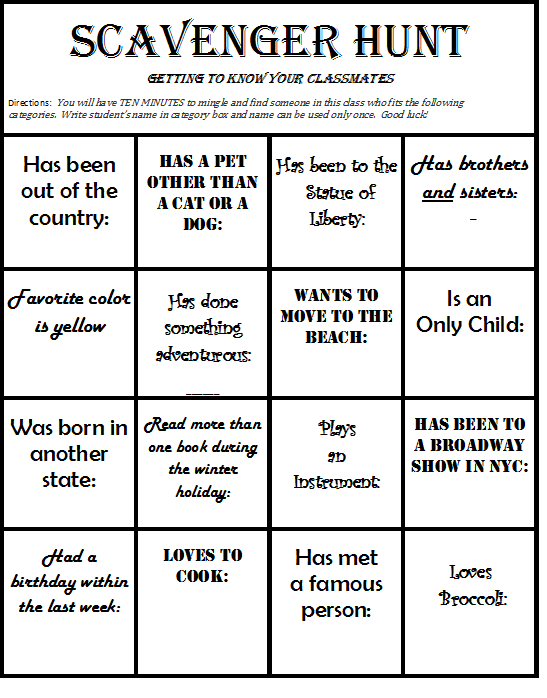|
The second semester can mean a new batch of students and an opportunity to build trust the very first day. Ice breaker activities are meant to ease nervousness of the unknown. Consider using the following borrowed and modified ideas: Extra! Extra! Talk All About It! Description: This is a fun way to break the ice and get participants to share and know more about each other. Application: Use at the beginning of a new school year or semester. Process: Create blank sandwich boards prior to class meeting and hand one to each participant. Provide markers. Give participants 10 minutes to think and write “headlines” to describe themselves. (Ex. Woman Meets Three Presidents in Three Months! “Bono hugs adoring fan at Raymond James Stadium”) Tell participants to write at least five headlines total and they may write on both sides. When time is called, instruct participants to "wear" their sandwich board, mingle, and ask questions to seek clarity about the headlines. Give the whole group up to 10 minutes to walk around the room. Expectations Ice-Breaker Description: Originally titled, A Classroom Icebreaker with a Lesson that Lasts, this ice-breaker combines purposes of students getting to know the instructor with behavior management. This wonderful protocol was conceived by Virginia Freed, formerly of Bay Path University. Application: Use this at the beginning of the year/semester as a way to remind students of classroom expectations in a non-threatening way. Process: Fill a box with about 15 random items (items can be large or small, from home or from work). At precisely the time class starts, walk into the room with the box. In silence, take each article out; place it on a table; and finally, when all of them are out, return the items to the box. Tell students to take out a sheet of paper and write down as many of the items as they can remember (and they remember very little). Students sitting in the back of the room have not been able to see the items on the table. The point- Sit as close to the front of the room as possible. Some students have been engaged in conversations and did not see the teacher or the box. The point-Pay attention right from the beginning of the class; teachers often offer the most interesting and important information at the beginning and ending of class. Some students come in late. The point-Arrive on time. Some students don’t have anything to write with or on. The point-Come prepared. Make immediate connections to the lack of answers (and student protests): Repeat the process, slowly taking each item one by one, placing it on the table, then returning them all to the box and ask the students to list as many as can be remembered. (The point-lists are longer because students are paying attention.) Repeat the process again and start class the next day with the same box and a marked improvement in understanding expectations. In-Class Scavenger Hunt Description: An in-class scavenger hunt is a “get to know you” game that is fun and engaging while allowing students to learn about others in the group. Application: Use as a great icebreaker activity or team building game at the beginning of a meeting, new academic year, or semester. Process: Create or use an existing scavenger hunt document. Hand one to each student and tell them that they will have ten minutes to mingle and find someone in the class who fits the categories. Remind them to write student’s name who provided the answer in the box. After mingle, randomly call on students to share answers. Virginia Freed, MEd, MA, is a Professor of English at Bay Path College.
Excerpted from Thinking Outside of the Box, The Teaching Professor, October 2008 Scavenger Hunt based on work by http://thesciencelife.blogspot.com/2012_07_01_archive.html
1 Comment
10/23/2019 04:11:44 am
Ice breakers are often my plan of action for when I host a program. I mean, what is the point of not having an ice breaker, right? Once we actually use ice breakers for our programs, then we are going to have a fun time. Not only do ice breakers, essentially, break the ice, but it also loosens up the mood. We all are better people, at least during programs, once we do a simple ice breaker, that is how I feel.
Reply
Leave a Reply. |
AuthorAlison Thetford, M.Ed CategoriesPast Posts
March 2024
|

